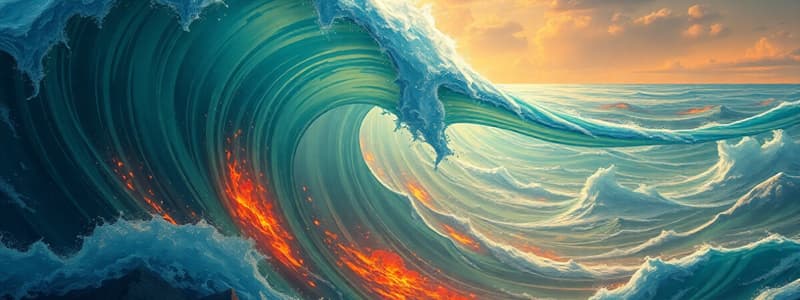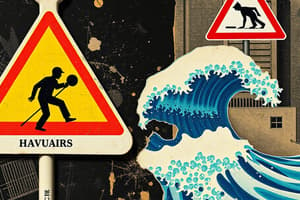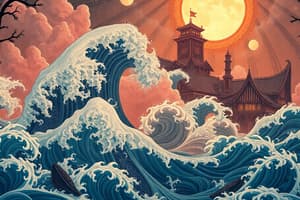Podcast
Questions and Answers
The term 'tsunami,' originating from Japanese, directly translates to which of the following?
The term 'tsunami,' originating from Japanese, directly translates to which of the following?
- Coastal deluge
- Ocean surge
- Seismic sea wave
- Harbor wave (correct)
Which geological event is LEAST likely to be a primary cause of a tsunami?
Which geological event is LEAST likely to be a primary cause of a tsunami?
- A powerful shallow earthquake at a subduction zone
- A large underwater landslide
- A minor tremor along a transform fault (correct)
- An explosive volcanic eruption
Although sometimes mistakenly called 'tidal waves', tsunamis are distinct phenomena. What is the primary difference between a tsunami and a typical tidal wave?
Although sometimes mistakenly called 'tidal waves', tsunamis are distinct phenomena. What is the primary difference between a tsunami and a typical tidal wave?
- Tidal waves are always single, isolated waves, but tsunamis always occur as a series of waves.
- Tsunamis are influenced by gravitational forces of the moon and sun, while tidal waves are caused by seismic activity.
- Tsunamis are generated by abrupt seafloor disturbances, whereas tidal waves are caused by gravitational forces. (correct)
- Tidal waves are deep-water waves, while tsunamis are shallow-water waves.
Based on the information provided, in which oceanic regions are tsunamis statistically more frequent occurrences?
Based on the information provided, in which oceanic regions are tsunamis statistically more frequent occurrences?
Observing a rapid withdrawal of the ocean from the shoreline is a critical natural warning sign for which impending natural disaster?
Observing a rapid withdrawal of the ocean from the shoreline is a critical natural warning sign for which impending natural disaster?
At what point does a tsunami typically become a significant threat to coastal areas?
At what point does a tsunami typically become a significant threat to coastal areas?
How does the appearance of a tsunami wave near the coast typically differ from a normal breaking wave at the beach?
How does the appearance of a tsunami wave near the coast typically differ from a normal breaking wave at the beach?
What is the primary purpose of the tsunami warning systems mentioned?
What is the primary purpose of the tsunami warning systems mentioned?
How does the energy and size of a tsunami wave generally change as it travels further from its origin point?
How does the energy and size of a tsunami wave generally change as it travels further from its origin point?
What is a characteristic feature of tsunami waves related to their occurrence in a series?
What is a characteristic feature of tsunami waves related to their occurrence in a series?
Flashcards
What is a tsunami?
What is a tsunami?
A giant wave caused by the sudden displacement of water, usually triggered by events such as earthquakes, volcanic eruptions, or underwater landslides.
How do tsunamis form?
How do tsunamis form?
Tsunamis form when underwater disturbances, like earthquakes or volcanic explosions, displace large volumes of water, creating powerful waves.
What are the causes of tsunamis?
What are the causes of tsunamis?
Tsunamis can be caused by a variety of events, including earthquakes, volcanic eruptions, landslides, and meteorite impacts.
Where are tsunamis most likely to occur?
Where are tsunamis most likely to occur?
Signup and view all the flashcards
Why are tsunamis so dangerous?
Why are tsunamis so dangerous?
Signup and view all the flashcards
How does a tsunami's size change?
How does a tsunami's size change?
Signup and view all the flashcards
How fast do tsunamis travel?
How fast do tsunamis travel?
Signup and view all the flashcards
Why does a tsunami grow larger near the shore?
Why does a tsunami grow larger near the shore?
Signup and view all the flashcards
What are the efforts for early tsunami warning?
What are the efforts for early tsunami warning?
Signup and view all the flashcards
Study Notes
Tsunamis: Understanding the Hazard
- Tsunamis are harbor waves, sometimes mistaken for tidal waves, but formed differently. They are characterized by unpredictable and dangerous behavior.
- They are typically a series of waves, formed by disturbances of the ocean floor.
- Common causes include: earthquakes (especially shallow, large ones at plate subduction zones), volcanic eruptions, underwater landslides, and meteorite impacts.
- Shallow earthquakes produce large-scale seafloor displacement, often leading to destructive events.
- The Indonesian tsunami of 2004, and the Japanese tsunami of 2011, are examples of devastating events.
Formation and Characteristics
- Tsunamis are significant, but relatively small, on open water (typically 1-2 feet).
- They build rapidly in shallow water due to friction with the seafloor.
- The front of the wave arrives at shallow water much earlier than the back, creating a chain reaction that increases wave height.
- This build-up is exacerbated by factors like coastal topography—a steep slope or a bay can further increase height.
- The appearance of a tsunami is often not a breaking wave but rather a rapid surge of water similar to a flooding river.
Tsunami Impact
- Tsunamis carry significant debris posing injury risks.
- One wave is rarely the only one; further waves tend to be more powerful, and they follow the first.
- The receding water, before a wave, is a warning sign.
- The speed of tsunamis is extremely high, exceeding 500 mph..
- The width of a single wave can span up to 100 miles.
Global Distribution and Risk
- Tsunamis can occur in all oceans. The Pacific and Indian Oceans, due to higher subduction zones and submarine activity, are more prone.
- Tsunamis travel great distances, causing damage far from their origin.
- The 2004 tsunami in Indonesia resulted in very severe damage and loss of life in Sri Lanka and India.
Monitoring and Warning Systems
- The U.S. National Oceanic and Atmospheric Administration has a network of instruments (seaborne and on the seabed) to monitor for tsunamis in the Pacific Ocean.
- Warning systems are designed to provide early warnings before reaching the land.
- The Indian Ocean also needs a greater system to alert people to the arrival of such a wave, as a lack of such a system contributed to the devastating 2004 event.
Personal Safety
- If on a beach and a tsunami warning is issued, seek higher ground immediately. Avoid collecting items on the beach.
- The height of the wave may not be as large as predicted or warned, but staying in danger's way is not recommended.
Studying That Suits You
Use AI to generate personalized quizzes and flashcards to suit your learning preferences.




